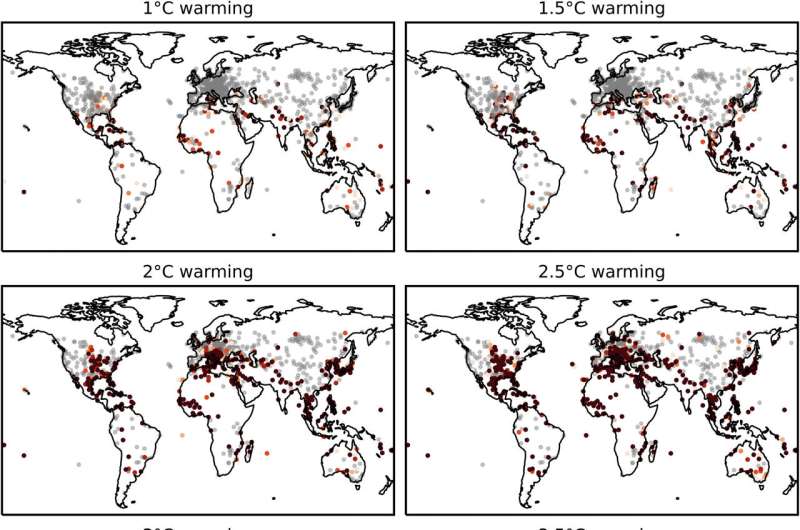September 11, 2023 report
This article has been reviewed according to Science X's editorial process and policies. Editors have highlighted the following attributes while ensuring the content's credibility:
fact-checked
peer-reviewed publication
trusted source
proofread
Model shows life-threatening heat events will happen more often and in more places as the world warms

A team of climate scientists at the Woodwell Climate Research Center in the U.S., working with a colleague from the Environmental Change Institute in the U.K., has found via climate modeling that many more life-threatening heat events are likely to happen around the world. In their study, reported in the journal Science Advances, the group used climate models and data from weather stations to make predictions about the number of places that will see serious heat events when global temperature landmarks are reached.
In 2010, a pair of climate scientists, Steven Sherwood and Matthew Huber, conducted experiments to find the upper limits of human survivability under heat stress. They used what has come to be known as the wet bulb test, in which a wet towel was placed over a thermometer to represent 100% humidity and temperatures were raised.
In their experiments, they found a boundary of six hours at a temperature of 35°C (95°F) as the upper limit of human survivability, when it is not possible for people to take actions to cool themselves. In this new effort, the research team collected data from thousands of weather stations around the world to learn more about the risks of heat events as increasing numbers of places become unlivable.
The research team noted that several places have already experienced such conditions, though all of them are in places where such conditions are expected, such as the Middle East and the North Indian Plain. They then trained a climate model on the data they had obtained and used it to make predictions about the places where they had obtained weather data from the stations. Predictions were made under multiple scenarios, all based on increases in global temperatures.
The model showed more places experiencing heat events that would not be considered survivable under the wet bulb test as the planet grows warmer. A global increase of 2°C, for example, would result in 25% more places experiencing such events. Those increases, the model showed, would sometimes be in places not accustomed to such heat, such as parts of the East Coast and Midwest in the U.S., and in central Europe.
They also found that for regions that are already hot, such experiences could become annual events. The team summarized their findings by suggesting that climate change is going to produce many more such events in the future in places that are not prepared to deal with them. The likely outcome, they suggest, could be a high number of deaths.
More information: Carter M. Powis et al, Observational and model evidence together support wide-spread exposure to noncompensable heat under continued global warming, Science Advances (2023). DOI: 10.1126/sciadv.adg9297
Journal information: Science Advances
© 2023 Science X Network





















